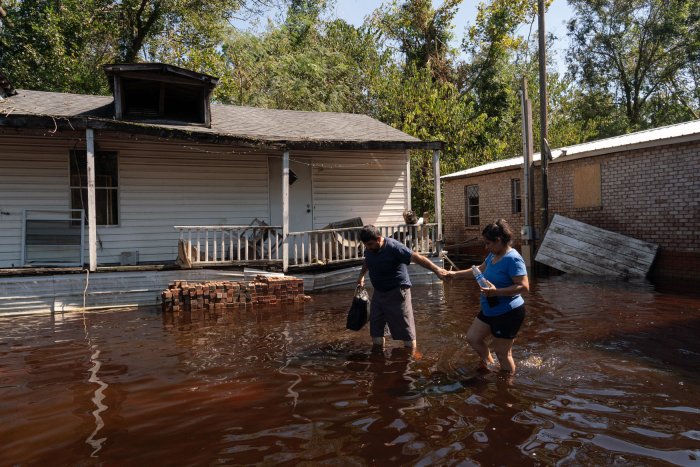A neighborhood in Chinquapin, N.C., is inundated with floodwaters on September 19, not long after Hurricane Florence moved out. File Photo by Ken Cedeno/UPI |
License Photo
Oct. 30 (UPI) -- More than a month after Hurricane Florence slammed the Carolinas with heavy rain, many people are still homeless and in desperate need of help, aid workers say.
The storm hit on Sept. 14 and caused widespread flooding and damage in South and North Carolina. Relief worker Ray Baca, of Port City Volunteer and Relief in the Wilmington, N.C., area, said hundreds still have no shelter after six weeks.
"There are still people who don't have houses," Baca, whose organization helps collect and distribute donated relief aid, told UPI. "There are close to 900 kids who are sleeping in cars or sleeping in tents in their yards because the insurance checks haven't come back yet."
While Hurricane Florence landed as a Category 1 storm, Michael Braxton said that distinction is deceptive. Through his work with Port City Volunteers, he said heavy rains from four straight days inflicted a great toll.
"All the hurricanes I've ever been through, they get in and get out," Braxton, who lives in Wilmington, told UPI. "They go eight to 12 hours, but this one sat four days. With all that rain and wind, [it] was a pain in the butt."
"People ask, 'How does it compare to [Hurricane Michael]?' And I say, there's no comparison. Michael was a Category 5, but didn't last long. This was definitely an interesting storm," Braxton said.
The Triangle Business Journal reported last month that damage calculations from Florence ranged from $19 billion to $28.5 billion, making it one of the costliest hurricanes in U.S. history.
"Hurricane Florence pummeled the Carolinas with strong winds, heavy rain and dangerous tidal surges," American Red Cross spokeswoman Stephanie Rendon told UPI. "Twice the size of Louisiana, Florence inundated communities and left hundreds of thousands without power."
More than 600,000 homes received some type of wind or water damage, and 2,600 commercial buildings were submerged in at least one foot of water.
"Florence is definitely a major flood loss event," CoreLogic senior director of model development David Smith told the Business Journal, noting that uninsured losses could top $18.5 billion.
At least 53 people died from something related to Hurricane Florence -- most in North Carolina, the state's Public Safety Department said
"Recovery from a hurricane is a long-term process," spokesman Thomas Gregory said. "We do have infrastructure repair needs for a number of roads, as well as local facilities. The priority is to get citizens back into their homes."
On Monday, North Carolina's federal disaster declaration was amended to include individual assistance for three more counties -- Chatham, Durham and Guilford -- and the American Red Cross said more than 200 people are still living in Red Cross shelters in the state. The agency said it's supported nearly 130,000 storm-related, overnight stays at Carolina shelters so far.
"We continue to work with partners to prepare and distribute meals to families affected by the storm," Rendon said. "To date, the Red Cross has served more than 2.84 million meals and snacks."
Braxton said he and Baca have been working with displaced people who often fall through the cracks and don't receive the help they need from the Red Cross, the Federal Emergency Management Agency and other groups.
"The outlying counties are in pretty bad shape," Braxton said. "A good 60 to 70 percent of people [who were displaced] are back in their homes, but there is still a good 30 percent and more who are still out. A lot of people still need help."
Baca, who earns his living as a wedding photographer, said the relief work he's been doing expressly shows how storm damage can linger well past the time the clouds dissipate.
"I lost 15 [wedding] events because of the storm," he said. "That killed my income. I haven't been able to pay rent for three months.
"It's been tough for everybody. It's not a black or white thing. It's not a rich or poor thing. The hurricane affected everybody."
Baca said Wilmington and surrounding areas will probably need help for months, or even a year, to get back to what he calls the "new normal." In the meantime, Braxton encourages donors to remember the harm caused by Hurricane Florence isn't completely gone.
"The thing you hate is that the first week after the storm, you get all of this news coverage and then they just move on to the next thing," Braxton said. "My wife teaches in Pender County and there are dire straits out there. They have families living in tents. The best thing they were able to do was to get the schools back open to return to some sense of normalcy.
"What we need is continued help -- and prayers."
Hurricane Florence strikes Carolinas
<< Show Caption >>
















